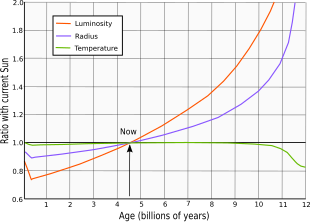Solar radius
| 1 R☉ = | Units |
|---|---|
| 6.95700×108 | metres |
| 695,700 | kilometres |
| 0.00465047 | astronomical unit |
| 432,288 | miles |
| 7.35355×10−8 | light-year |
| 2.25461×10−8 | parsec |
| 2.32061 | light-seconds |
Solar radius is a unit of distance used to express the size of stars in astronomy relative to the Sun. The solar radius is usually defined as the radius to the layer in the Sun's photosphere where the optical depth equals 2/3[citation needed]:
695,700 kilometres (432,300 miles) is approximately 10 times the average radius of Jupiter, about 109 times the radius of the Earth, and 1/215th of an astronomical unit, the distance of the Earth from the Sun. It varies slightly from pole to equator due to its rotation, which induces an oblateness in the order of 10 parts per million.[1]
Measurements

The unmanned SOHO spacecraft was used to measure the radius of the Sun by timing transits of Mercury across the surface during 2003 and 2006. The result was a measured radius of 696,342 ± 65 kilometres (432,687 ± 40 miles).[3]
Haberreiter, Schmutz & Kosovichev (2008)[4] determined the radius corresponding to the solar photosphere to be 695,660 ± 140 kilometres (432,263 ± 87 miles). This new value is consistent with helioseismic estimates; the same study showed that previous estimates using inflection point methods had been overestimated by approximately 300 km (190 mi).
Nominal solar radius
In 2015, the International Astronomical Union passed Resolution B3, which defined a set of nominal conversion constants for stellar and planetary astronomy. Resolution B3 defined the nominal solar radius (symbol ) to be equal to exactly 695700 km.[5] The nominal value, which is the rounded value, within the uncertainty, given by Haberreiter, Schmutz & Kosovichev (2008), was adopted to help astronomers avoid confusion when quoting stellar radii in units of the Sun's radius, even when future observations will likely refine the Sun's actual photospheric radius (which is currently[6] only known to about an accuracy of ±100–200 km).
Examples
Solar radii as a unit are common when describing spacecraft moving close to the sun. Two spacecraft in the 2010s include:
- Solar Orbiter (as close as 45 R☉)
- Parker Solar Probe (as close as 9 R☉)
See also
- Astronomical unit
- List of largest known stars
- Orders of magnitude (length)
- Solar luminosity
- Solar mass
- Earth Radius
References
- ^ NASA RHESSI oblateness measurements 2012
- ^ Ribas, Ignasi (August 2009). "The Sun and Stars as the Primary Energy Input in Planetary Atmospheres" (PDF). Proceedings of the International Astronomical Union. 5 (S264 [Solar and Stellar Variability: Impact on Earth and Planets]): 3–18. arXiv:0911.4872. Bibcode:2010IAUS..264....3R. doi:10.1017/S1743921309992298. S2CID 119107400.
- ^ Emilio, Marcelo; Kuhn, Jeff R.; Bush, Rock I.; Scholl, Isabelle F. (2012), "Measuring the Solar Radius from Space during the 2003 and 2006 Mercury Transits", The Astrophysical Journal, 750 (2): 135, arXiv:1203.4898, Bibcode:2012ApJ...750..135E, doi:10.1088/0004-637X/750/2/135, S2CID 119255559
- ^ Haberreiter, M; Schmutz, W; Kosovichev, A.G. (2008), "Solving the Discrepancy between the Seismic and Photospheric Solar Radius", Astrophysical Journal, 675 (1): L53–L56, arXiv:0711.2392, Bibcode:2008ApJ...675L..53H, doi:10.1086/529492, S2CID 14584860
- ^ Mamajek, E.E.; Prsa, A.; Torres, G.; et, al. (2015), IAU 2015 Resolution B3 on Recommended Nominal Conversion Constants for Selected Solar and Planetary Properties, arXiv:1510.07674, Bibcode:2015arXiv151007674M
- ^ Meftah, M; Corbard, T; Hauchecorne, A.; Morand, F.; Ikhlef, R.; Chauvineau, B.; Renaud, C.; Sarkissian, A.; Damé, L. (2018), "Solar radius determined from PICARD/SODISM observationsand extremely weak wavelength dependence in the visibleand the near-infrared", Astronomy & Astrophysics, 616: A64, Bibcode:2018A&A...616A..64M, doi:10.1051/0004-6361/201732159
External links
- S. C. Tripathy; H. M. Antia (1999). "Influence of surface layers on the seismic estimate of the solar radius". Solar Physics. 186 (1/2): 1–11. Bibcode:1999SoPh..186....1T. doi:10.1023/A:1005116830445. S2CID 118037693.
- T. M. Brown; J. Christensen-Dalsgaard (1998). "Accurate Determination of the Solar Photospheric Radius". Astrophysical Journal Letters. 500 (2): L195. arXiv:astro-ph/9803131. Bibcode:1998ApJ...500L.195B. doi:10.1086/311416. S2CID 13875360.


